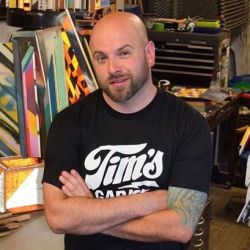James Chase is the Director of Community Education and Visual Arts Faculty at the New Hampshire Institute of Art, as well as a board member for the Rochester Museum of Fine Arts. He’s a national and internationally exhibiting artist, merging painting, printmaking, and photography with social engagement practices. Since 2009, he has been featured in over 50 art exhibitions. Recent exhibitions include Picked Six Contemporary Art Month in San Antonio 2015 and Memory Palace 2016 at Manifest Gallery in Cincinnati, OH. Recent solo exhibitions include Echoes at the RMFA and Kill The Lights at South Plains College in Levelland, Texas.
The work of artist James Chase explores ideas of collection, repetition, and memory. Discarded wooden slats and blocks are collected and repurposed to form the structural and visual elements of Chase’s work. Trained in printmaking, Chase creates traditional prints but has also developed an approach to printmaking in which older prints are cut up and reassembled to form a new composite image against the background of the found objects. For Chase, the collection of found objects is a means of mentally mapping out time and place. The layering, stacking, and painting of materials reference the accumulation of memories (and the objects that represent them) and the ways in which memories can be altered, replaced, or forgotten over time. The use of bright colors and abstract geometric forms on found objects results in an image that is familiar but unrecognizable – a reflection of our ability as human beings to relate and remember as well as our inability to ever fully relive a memory or experience reality from another’s perspective

